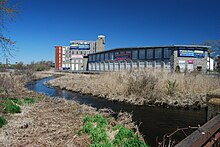Quequechan River
| Quequechan River | |
|---|---|

View looking west from Quequechan Street, Fall River
|
|
| Basin features | |
| Main source |
South Watuppa Pond 129 feet (39 m) |
| River mouth | Taunton River |
| Basin size | 31 square miles (80 km2) |
| Physical characteristics | |
| Length | 2.7 miles (4 km) |
| Discharge |
|
Coordinates: 41°41′44″N 71°8′50″W / 41.69556°N 71.14722°W
The Quequechan River is a river in Fall River, Massachusetts, that flows in a northwesterly direction from the northwest corner of the South Watuppa Pond through the heart of the city of Fall River and into to the end of the Taunton River at Mount Hope Bay at Heritage State Park/Battleship Cove. The word Quequechan means "Falling River" or "Leaping/Falling Waters" in Wampanoag, hence the city's name.
The river is 2.7 miles (4.3 km) and is mostly placid and stagnant in certain places, until it nears downtown Fall River near City Hall, where a quickly declining grade causes it to turn rapid down the hill into Mount Hope Bay/Taunton River. From 1813, with the establishment of the Fall River Manufactory, the river enabled Fall River to establish itself as a leading textile center during the early 19th century. It originally contained a series of eight small waterfalls in a narrow stream between what is now South Main Street and the tidal Taunton River. During the first half of the 19th century, the "Fall River" was nearly completely covered by textile mills. The upper portion of the river, east of Pleasant Street, was dammed to provide additional water power and storage for the mills.
Between 1913 and 1914, the city of Fall River put together the Quequechan River Report published in 1915, to look into the problems the river was presented with. During the hot summer months, the water flowed very low and slowly and the water quality was becoming questionable. Chemical reactions were occurring occasionally on the river's edge from industrial mill wastes combined with hot water discharge, human wastes and other wastes (a dump was located on the river), causing further sanitary health concerns, and interest in the river in general.
...
Wikipedia
